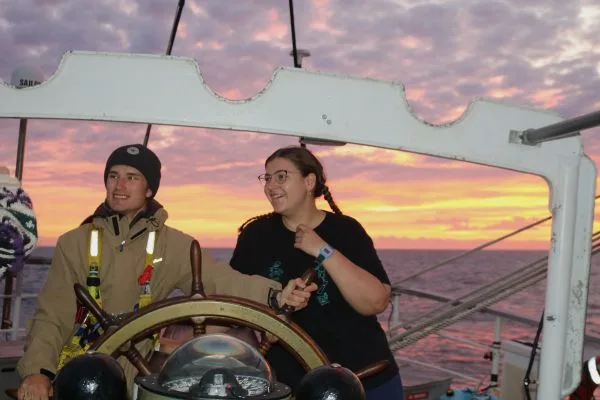Programs Blog
Within the Bioluminescence

Author: Kristin Zunino, College of the Atlantic (C Watch)
Ship’s Log
March 9, 2024Position: 40°39.239’S x 170°45.735’EHeading and speed: 190°, 6.3 knotsWeather: Force 7 winds coming from the SSW and 4 foot seas from the S. It iscloudy out with cirrus and altocumulus clouds. The temperature is 14°C.
The day started for C watch at our 0100 watch rotation. It was a beautifulnight motor sailing along to our waypoint within Otago Anchorage where wewill soon anchor for the night (as of 1700 when I’m writing this). We havestarted shadowing our mates, 3 hours of the watch we learn, observe, and askas many questions we have about their role in operations. Plus, we get toassist in these activities to better hone our ever-advancing trainingincluding: turnovers, check-ins with the captain, more chart handling,course order changes, monitoring traffic, and calling out sails. Overall, Ithink Julian and I did a great job shadowing. The watch was fun! We struckthe jib and went out on the head rig to furl it. It’s always a surrealexperience clipping in on the head rig during the night hours. In betweenthe netting all one sees is darkness and gleams from the water below. Itfeels as though we shouldn’t be there, yet know that we are safe and awareof our surroundings.Though we worked in the hours of darkness, there was light all around usfrom the stars in the sky to the bioluminescence below. The stars wereabsolutely breathtaking tonight lighting up the night sky. A ghost-like pathof the milky way ran through the sky and the Southern Cross. The SouthernCross is right where it usually is, shinning bright directly above us withthe rest of the stars rotating around it. We can see at least two planetstonight: Venus and Mars with its orange hue. Below water was lit by theabundance of blue bioluminescence. The blue glow activated by us making waythrough the water. They filled the waters next to us on either side.Dolphins came to join, blue glows moving over their bodies as they dipped inand out of our wake. Everyone rushed to the bow to see them. It wasmesmerizing to watch… one of my favorite things from dawn watches thus far.This watch in particular made me feels grounded and at peace with everythingin life. The ocean is so lively around us. The liveliness really hit when Iwoke up for lunch to the force 7 winds and 5 foot swells A watch wasnavigating through.Questions I have since being underway (I don’t want answers):– Do dentists get commissions on each tooth they pull? If so doesthe price range based on type: baby teeth, molars, wisdom teeth, etc.?– What is the noodle that is spiral like a perfect curly fry, ishollow like a tube, and starts with a ‘c’ (good for mac n’ cheese)?– Can you overdo it with electrolytes? What is the limit?– Hypothetically would a bull shark more-likely attack someone inthe ocean or in a river?– Why does Swiss cheese not melt well? How do the holes get there?– Who decided to have a leap day every four years? I understand whywe have one but what was the name of the person who decided this?– Is tonic water just seltzer in a fancy bottle?– What’s the fastest time someone has eaten corn on the cob(cooked)?– How old would Abraham Lincoln be right now if he was alive?– Can one truly be a biohazard to one’s self?Kristin ZuninoC WatchCollege of the Atlantic
Recent Posts from the Ships
- Ocean Classroom 2024-A collaborative high school program with Proctor Academy
- Collaborations and Long-term Commitments: SEA’s Caribbean Reef Program Sets a Course for Coastal Programs that Compliment Shipboard Experiences.
- Sea Education Association students prepare for life underway using state of the art nautical simulation from Wartsila Corporation.
- SEA Writer 2022, Magazines From the Summer SEA Quest Students
- Technology@SEA: Upgrades Allow Insight into Ocean Depths
Programs
- Gap Year
- Ocean Exploration
- High School
- Science at SEA
- SEA Expedition
- SEAScape
- Pre-College
- Proctor Ocean Classroom
- Protecting the Phoenix Islands
- SPICE
- Stanford@SEA
- Undergraduate
- Climate and Society
- Climate Change and Coastal Resilience
- Coral Reef Conservation
- Marine Biodiversity and Conservation
- MBL
- Ocean Exploration: Plastics
- Ocean Policy: Marine Protected Areas
- Oceans and Climate
- Pacific Reef Expedition
- The Global Ocean: Hawai'i
- The Global Ocean: New Zealand